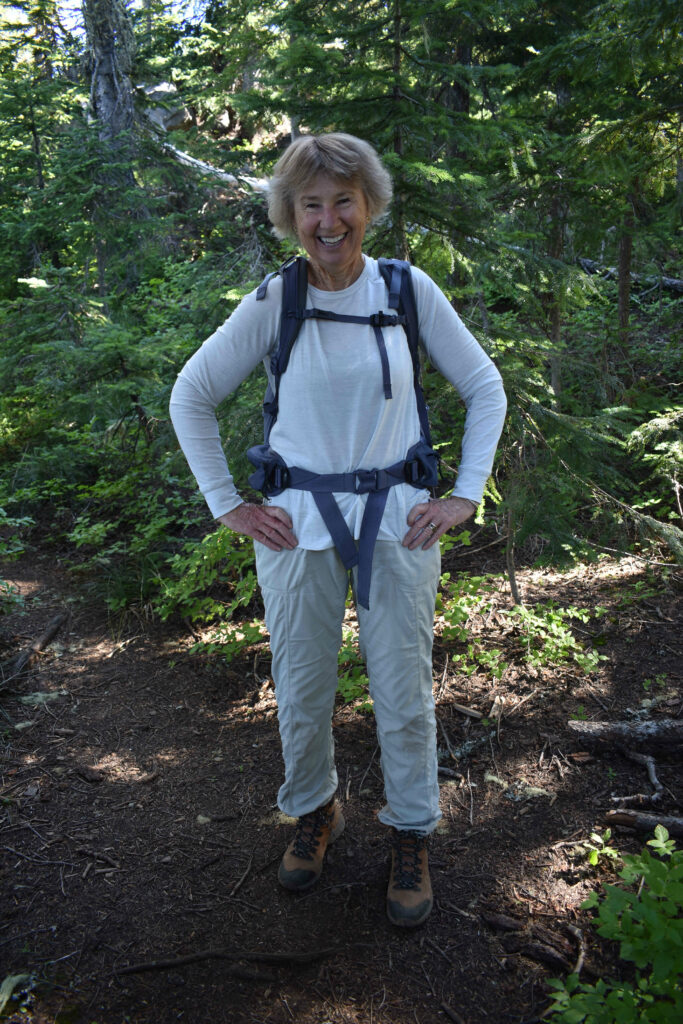Gail Baker
Last Updated on March 23, 2024 by Tom Pratum
Making botanical connections

The move from California to Oregon in the early 1980s landed Gail in her ideal botanical landscape and climate zone, between the northeastern North America of her childhood, a place with distinct seasons, and California’s Mediterranean climate, where she was introduced to and fell in love with plant ecology and botany as an undergraduate at UC Irvine. After completing a Master of Science degree at San Diego State University, Gail launched her ten-year research career, first back at UC Irvine, then at UCLA, and finally at Oregon State Universities Forest Science Lab, exploring chaparral, desert and mountain ecosystems in the western United States, Baja, Hawaii, and Chile.
During this time, Gail dabbled in teaching part-time and knew she wanted to transition to an academic teaching position. The opportunity came in 1994 when she was hired by Lane Community College (LCC) in Eugene, Oregon. The dream job Gail stepped into was teaching biology majors’ and plant science courses with an emphasis on field experience.
Teaching allowed Gail to completely immerse herself in Oregon’s flora, as well as an opportunity to join the Native Plant Society of Oregon. Gail became fast friends with Rhoda Love and others in the Emerald Chapter along with botanical colleagues at UO and OSU. A favorite aspect of Gail’s work included leading plant walks and coordinating the annual Wildflower Festival at Mount Pisgah Arboretum (MPA), and especially exploring Oregon’s plant communities with her students. Gail is most proud of expanding plant science courses at LCC by building on the foundation of field courses established by her mentors and colleagues Rhoda Love and Freeman Rowe.
When the LCC Science & Math Building was remodeled in 2000, Gail helped design a separate herbarium space, dedicated in 2004 as the Rowe-Love Herbarium (LCEU), along with a large refrigeration room to store plant specimens for classes, which reduced the necessity for frequent collecting of fresh specimens for classroom observation. The remodel was also an opportunity to initiate The Native Plant Landscape Project surrounding the LCC Science & Math Building. As a result of much planning and convincing of the campus community, local native plants were established and have provided a study site for undergraduate research projects, specifically phenology monitoring and pollination biology.
During Gail’s tenure as professor at LCC, she taught multiple generations of students the value of thinking like a scientist; many of her former students are now professionals (locally and beyond) in botanical fields. Numerous current and former NPSO officers and members passed through Gail’s classroom, and uncounted members of the public have benefited from her presentations and field trips. Gail has written many articles for the NPSO Bulletin and guided her students to do the same. Beyond inspiring students to appreciate the wonders of the plant world, she was an invaluable colleague and mentor to fellow faculty at LCC, helping to re-envision and improve curricula to meet national standards in science education.
Serving NPSO at both Chapter and State levels opened up a network of personal and professional connections for Gail that she feels honored to be a part of. She started as Emerald Chapter President from 1986 to 1988, then served as Co-President from 1997 to 1999; she is currently Emerald Chapter Program Chair. Gail has presented many programs for NPSO Chapters and our conservationist allies. At the state level, she gave the keynote presentation at the 1987 NPSO Annual Meeting in Portland; and she organized and led field trips for Annual Meetings in 1999, 2008 and 2016. She has served as a director on the State Board and is presently State Vice President and NPSO iNaturalist Committee Chair. The latter is a new committee Gail established to broaden NPSO’s outreach and connection with online community community-science participation.
Always endeavoring to relate botany to all interests in our community, Gail coordinated botanical art exhibits at galleries in Eugene to coincide with the MPA Wildflower Festival; organized a botanical illustration workshop, taught by Linda Vorobik, in 2013; led botanical bike rides to plant-themed urban art in Eugene; and developed curriculum for a botanical field trip to farmers’ markets. Gail’s A Botanical Field Trip to the Lane County Farmers’ Market to Make Connections with People, Place & Sustainability was published in LCC’s annual academic journal of scholarly work, The Community College Moment, in 2006.
Gail’s commitment to native plant conservation compelled her to testify before the Oregon State legislature in 1987 in support of the Oregon Endangered Species Act. From 2011 to 2017 Gail served on the Oregon Flora Project Advisory Committee including Committee chair from 2015-2016.
To pave the way for an active retirement full of plants Gail joined the Friends of Buford Park (FBP) Stewardship Technical Advisor Committee participating in restoration projects, plant surveys and supervising a phenology monitoring project for the FBP Native Plant Nursery. She currently Co-Chairs STAC.
Gail loves to be outside exploring landscapes and the interactions between plants and animals. Since her retirement in 2012 she has had more freedom to travel with her family to biologically interesting regions where they immerse themselves in local environments make connections between people, plants, food— trying to visit every farmer’s market. Lately Gail has taken to documenting her biological discoveries on iNaturalist, allowing other ecology enthusiasts to travel along with her!
—Karl Anderson, Emerald Chapter
With contributions from Susan Holmes, Jennifer Love and Tobias Policha
